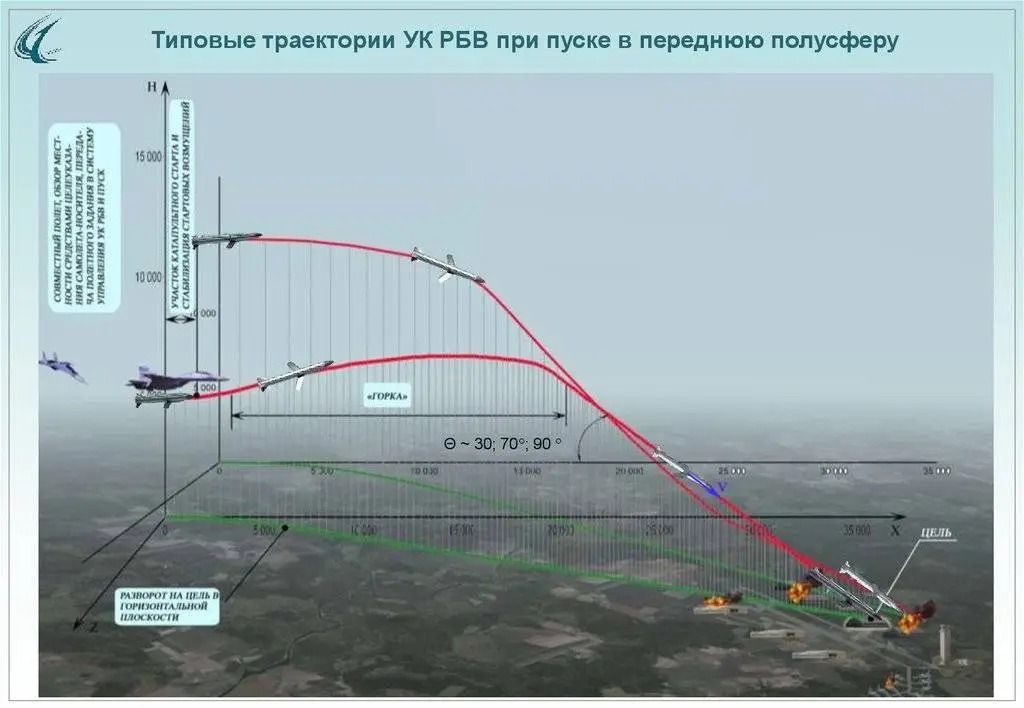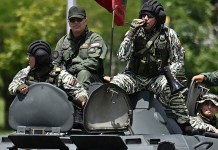On October 9, 2025, at approximately 18:15 local time (UTC+3), Russian forces struck a target in the Chechel district of Dnipro city, located roughly 120 km inside Ukrainian-controlled territory from the nearest front line in the Zaporizhzhia direction.
A video posted on social media showed a blurred object flying through the night sky toward its target, followed by images of a column of dark gray smoke rising above the city.
The flight path indicated that the weapon was gliding before impact. It is widely believed that the striking weapon was a Grom-E1 boosted glide bomb.
The Grom Weapons Family
The Grom family of air-launched weapons represents extended-range variants of the Kh-38 missile series and includes the Grom-E1 and Grom-E2 guided glide bombs.
Both variants incorporate the solid-fuel rocket engine derived from the Kh-38ME family of short-range air-to-surface missiles.
Unlike the Kh-38, which features fixed fins, the Grom series employs foldable wings, providing a longer range and allowing the missile to approach the target from virtually any direction.
The “E” designation traditionally denotes an export variant of the weapon system.
Both the Grom-E1 and Grom-E2 have a normal aerodynamic configuration and a common cylindrical body with an ogive nose cone, folding swept-back mid-body wings, and an aft actuator assembly. The weapons can be carried externally or internally within the bomb bays of fifth-generation combat aircraft.
Russia positions the Grom series as an analogue to the American JDAM-ER precision-guided bomb family.
Grom-E1 Specifications
The Grom-E1 missile has a launch mass of 594 kg, a length of 4.2 m, a body diameter of 0.31 m, and a wingspan of 1.9 m. It carries a 315 kg high-explosive (HE) fragmentation warhead equipped with an impact fuze.
The weapon uses two-stage solid-fuel rocket propulsion—a booster rocket for initial acceleration and a sustainer rocket for extended flight. It can be launched from altitudes between 500 and 12,000 meters and speeds ranging from 140 to 445 m/s.
Depending on launch parameters, the missile can strike targets 10–120 km away. Its wing-generated lift facilitates approach from unexpected directions, up to 80 degrees on either side of the launch vector.
Under optimal conditions (launch at 12,000 m altitude and 445 m/s speed for a 120 km strike), the missile maintains an average flight speed of 300 m/s and can sustain maneuvers up to 4 g.
For guidance, the Grom-E1 employs an inertial navigation system (INS) with GLONASS satellite updates. This combination enables high precision but limits the weapon to static targets with known coordinates, unlike the Kh-38 family, which can target moving objects using thermal imaging (TI) or semi-active laser homing (SALH) seekers.

Grom-E2 Specifications
The Grom-E2 variant has a slightly higher launch mass of 598 kg while retaining the same length, diameter, and wingspan as the Grom-E1. It forgoes the second-stage sustainer motor to accommodate two warheads—a 315 kg fragmentation warhead in the nose and a 165 kg warhead at the rear of the fuselage, occupying the space of the omitted motor.
This configuration increases the total explosive mass to 480 kg, enhancing destructive power but reducing range. The Grom-E2 can be launched from altitudes between 500 m and 12,000 m, at speeds from 140 to 445 m/s, to engage targets 10–50 km away.
Given that the Dnipro target was struck at a distance of approximately 120 km from the front line, analysts rule out the use of the Grom-E2, identifying the weapon as a Grom-E1 instead.
Past Use Of Grom Missiles
Russia’s first reported use of the Grom-E1 occurred in early September 2024 during an attack on Kharkiv, when the city’s Trade Center and Sports Palace—reportedly converted for military use—were hit.
According to an October 2024 Telegraph report, Grom-E1 missiles were also employed in strikes against Mirnograd, Kherson, and Kharkiv, marking a clear operational pattern of using these munitions against fortified or strategically valuable urban targets.
Plugging A Precision Strike Gap
Before the Grom-E series entered service, Russia faced a capability gap between its UMPK glide bombs (such as the FAB-250 and FAB-500, with ranges up to 80 km) and Geran-2 drones, which can strike targets far beyond that range but deliver relatively small 90 kg warheads.
The Grom-E1 fills this gap, combining extended range with a significantly heavier warhead and high accuracy, thereby expanding Russia’s precision-strike options.
However, despite their advantages, the Grom-E1 and E2 variants remain limited to fixed targets, unlike the Kh-38 family’s modular variants, which are capable of engaging moving or relocatable targets using diverse seeker heads (SALH, radar homing, TI, or SATNAV).
Analysis
The successful strike on Dnipro—120 km from the nearest frontline—indicates a serious degradation in Ukrainian air defenses near the Zaporizhzhia sector.
The Russian aircraft launching the Grom-E1, likely a Su-34, Su-35S, or Su-30SM, would have been positioned near or slightly within Ukrainian airspace at the moment of release. This would only have been feasible if Ukrainian short- or medium-range air defense systems were absent or suppressed in the area.
In recent months, Russia has intensified its use of Geran-2 drones for both frontline and deep-interior strikes. Their growing effectiveness near the front lines can be attributed to several key upgrades:
Heavier warheads (~90 kg) compared to kamikaze drones like the Lancet (3 kg) or FPV drones (1–3 kg).
Forward-looking EO sensors and mesh-network communication links, allowing real-time remote piloting and precision strikes on moving targets.
Mass production at scale, enabling technological enhancements without excessive cost increases.
These tactical shifts suggest a deliberate Russian strategy aimed at eroding Ukrainian morale, destroying command and logistics infrastructure, and, most crucially, degrading Ukraine’s air defense networks ahead of larger offensive operations.
The degraded air defense networks, in turn, facilitate more effective use of weapons such as the Grom-E1.
- Vijainder K Thakur is a retired IAF Jaguar pilot, author, software architect, entrepreneur, and military analyst.
- Follow the author @vkthakur




